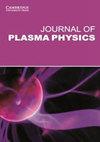Spatial distribution of self-seeded air lasers induced by the femtosecond laser filament plasma
IF 2.5
3区 物理与天体物理
Q2 PHYSICS, FLUIDS & PLASMAS
引用次数: 0
Abstract
The femtosecond laser filament-induced air laser plays a significant role for the remote sensing of air pollutants. The spatial distributions of air laser intensity were investigated experimentally in previous studies. However, the mechanism of the air laser propagation properties inside the filament plasma has not been quite clear yet. Moreover, few studies have been dedicated to the reproduction of the air laser profile from nitrogen molecules propagating in the filament plasma based on the numerical simulation method. In this study, the lasing action of the air laser from the transition of the first negative (0,0) band of nitrogen ions at 391 nm was simulated during the femtosecond laser filamentation. The beam profile of the air laser changes from a Gaussian or super-Gaussian shape to an outer ring structure by increasing the filament length or nitrogen ion density, which is in accord with the previous experimental result. A multiple-diffraction effect has been proposed to clarify the mechanism of the outer rings beam pattern formation, which is induced by the dynamical interaction between the lasing effect and diffraction effect of the air laser propagating inside the filament plasma. In addition, the amplified air laser power as a function of both the filament length and nitrogen ion density was investigated. Our study would pave the way to improve the energy conversion efficiency and directivity of remote air lasers, which would be significant for remote sensing applications.飞秒激光灯丝等离子体诱导的自播空气激光器的空间分布
飞秒激光丝诱导的空气激光在空气污染物遥感方面发挥着重要作用。之前的研究已经对空气激光强度的空间分布进行了实验研究。然而,空气激光在灯丝等离子体内部传播特性的机理还不十分清楚。此外,基于数值模拟方法再现氮分子在灯丝等离子体中传播的空气激光剖面的研究还很少。本研究模拟了在飞秒激光灯丝化过程中,氮离子在 391 纳米波长的第一个负(0,0)波段转变产生的空气激光的激光作用。随着灯丝长度或氮离子密度的增加,空气激光的光束轮廓从高斯或超高斯形状变为外环结构,这与之前的实验结果一致。多重衍射效应被提出来阐明外环光束图案的形成机制,它是由空气激光在灯丝等离子体内传播时的激光效应和衍射效应之间的动态相互作用引起的。此外,还研究了放大的空气激光功率与灯丝长度和氮离子密度的函数关系。我们的研究将为提高远程空气激光器的能量转换效率和指向性铺平道路,这对遥感应用意义重大。
本文章由计算机程序翻译,如有差异,请以英文原文为准。
求助全文
约1分钟内获得全文
求助全文
来源期刊

Journal of Plasma Physics
物理-物理:流体与等离子体
CiteScore
3.50
自引率
16.00%
发文量
106
审稿时长
6-12 weeks
期刊介绍:
JPP aspires to be the intellectual home of those who think of plasma physics as a fundamental discipline. The journal focuses on publishing research on laboratory plasmas (including magnetically confined and inertial fusion plasmas), space physics and plasma astrophysics that takes advantage of the rapid ongoing progress in instrumentation and computing to advance fundamental understanding of multiscale plasma physics. The Journal welcomes submissions of analytical, numerical, observational and experimental work: both original research and tutorial- or review-style papers, as well as proposals for its Lecture Notes series.
 求助内容:
求助内容: 应助结果提醒方式:
应助结果提醒方式:


